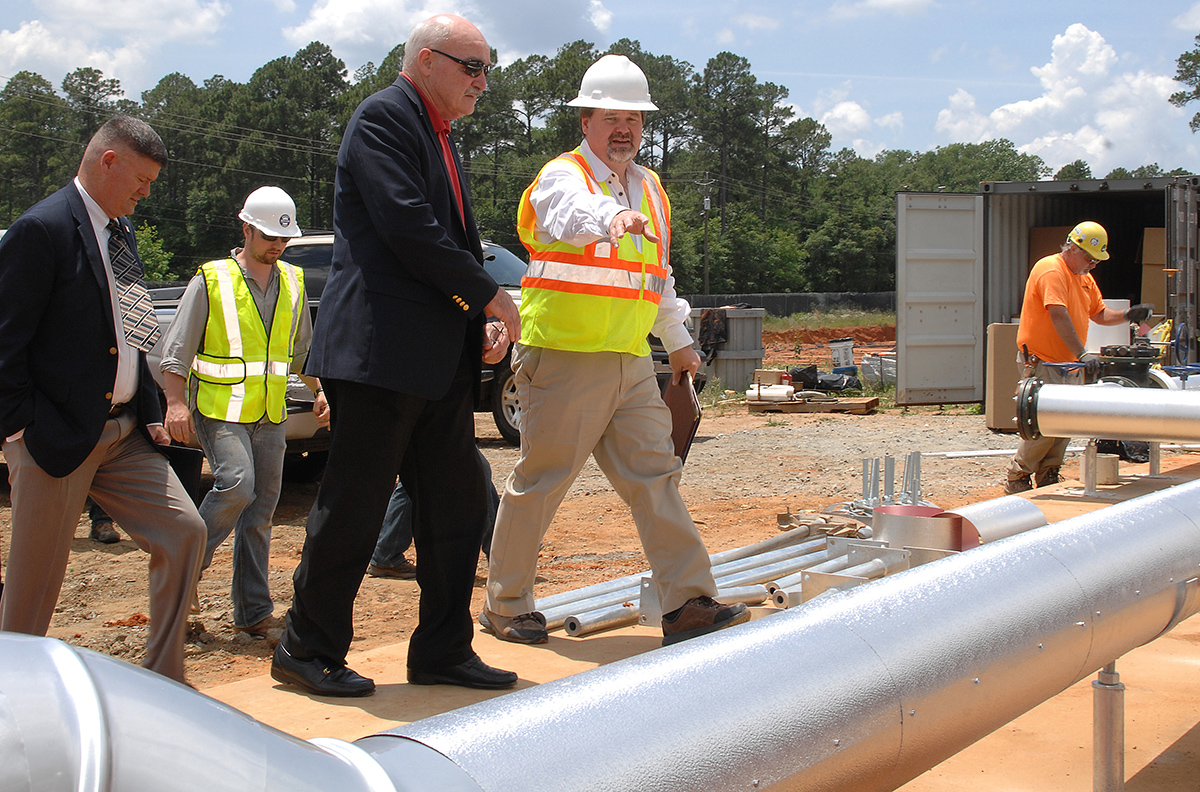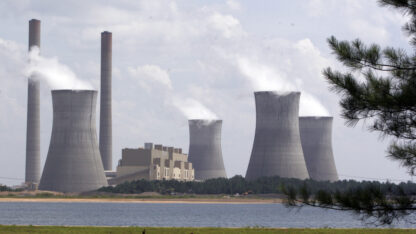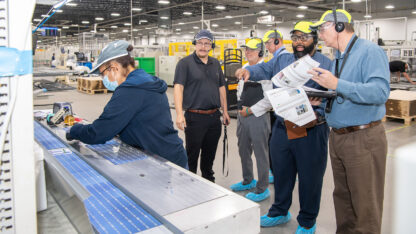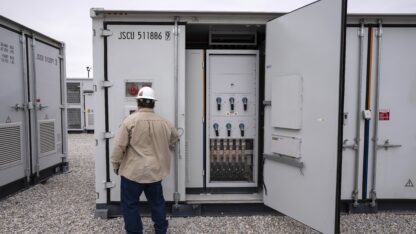This coverage is made possible through a partnership with WABE and Grist, a nonprofit, independent media organization dedicated to telling stories of climate solutions and a just future.
Georgia is really hot for a lot of the year, and expected to get hotter as climate change worsens.
That means air conditioners fight an uphill battle here, trying to get sweltering air from the 80s, 90s or even over 100 degrees down to something liveable.
Traditional air conditioning systems push heat outdoors as they cool the air inside. But a Macon-based engineering firm pioneered technology at two Georgia military bases that instead uses the earth to store cold or warm water. This basic idea for a more energy efficient heat pump system isn’t new, but adding a storage element is, at least in the US.
The systems save energy, which helps address climate change — and are also saving the military money.
With a traditional air conditioner, “You’re pumping heat from inside to outside,” explained Chuck Hammock, a Macon engineer who specializes in heating, ventilation and air conditioning systems. “But the outside is hot, it doesn’t want that heat.”
So the air conditioner uses a huge amount of energy to force the heat out into the already-hot summer air. This, of course, drives up electricity bills. And in Georgia, a lot of that power comes from burning natural gas, which contributes to climate change.
But what if the air conditioner could send that extra heat somewhere cooler, more ready to absorb it? Like underground, where the temperature stays pretty steady, in the 60s?
“It takes a whole lot less energy to move that heat uphill. The hill’s a lot smaller,” Hammock said.
This is the basic idea of a geothermal heat pump: by using the constant temperature under the earth, it’s possible to heat and cool a building with far less energy. Hammock’s company, AH&P Consulting Engineers, has found a way to make it even more efficient: storage.
A geothermal heat pump requires a system of holes bored deep into the ground with plastic pipe inside them, circulating water from the building to the ground and back. At Marine Corps Logistics Base Albany, Hammock’s company did this in a bullseye pattern, so there’s a well-insulated core. In winter, the cold air chills the water, which travels to that core first and then moves outward.
“We are putting our cold in the middle where we can preserve it or we can utilize it,” Hammock said.
Come summer, and brutal Georgia heat, that stored cold water goes back into the building.
“And the air conditioning unit says hey, I love that, this is great. I thought it was 95 degrees outside, but you’re sending me 70-degree water,” he said.
So the air conditioner for that facility has a lot less work to do.
“We have 50% saving on electricity in that building just because of that system,” said Hubert Smigelski, who oversaw this project as Deputy Director of Installation and Environment at MCLB Albany. He retired from that post last year.
“That’s something that every base, whether it be a Marine Corps, Navy, Army, whoever could look into, and we tried to get them to do it,” Smigelski said. “Because that can be used anywhere.”
Hammock’s company installed a similar system at Fort Benning, near Columbus, using an underground aquifer to preserve the winter cold rather than the insulation of the ground itself.
The pair of geothermal systems are a demonstration project through the Department of Defense’s Environmental Security Technology Certification Program, and it was deemed a success, cutting energy use roughly in half at both sites. The systems were named ESTCP Project of the Year in 2017, and MCLB Albany funded three more geothermal systems serving 10 additional buildings.
The heat pumps are part of a broader effort at making military installations more environmentally friendly. Last year, President Joe Biden issued an order calling for federal operations to reach net-zero emissions by 2050.
The order highlighted MCLB Albany for achieving net zero at the start of this year, meaning that all its energy is produced on the base rather than relying on the broader energy grid. In addition to improving efficiency, the base has reached that goal with the help of a nearby biomass plant and landfill generator.
While those energy sources don’t exist near every military base, geothermal heat pump systems will work just about anywhere because the temperature underground stays pretty consistent, no matter the weather conditions.
But there is one caveat, according to Marilyn Brown, who studies sustainable energy at the Georgia Tech School of Public Policy: in many places, it’s tough to add a heat pump to an existing building.
“Usually if you’ve got a facility already occupied, you don’t have the luxury of ripping up the infrastructure to put in the pipes needed,” she said.
Still, with enough space, Brown said geothermal heat pumps are a great solution. And adding the storage component pioneered at MCLB Albany and Fort Benning is a “valuable incremental improvement” in efficiency, according to Brown. That’s key, because when it comes to efficiency, every little bit helps.
“Energy efficiency is the cleanest and most affordable source of energy across the board,” she said, explaining that it’s cheaper to use less energy than it is to generate new energy and deliver it where it’s needed.
Brown said although these systems save energy, and therefore money, they do have a steep upfront cost, so they’re often a better fit for an institution like the military, a college or a large company than for the average homeowner.
But, she says, with financing or incentives, heat pumps could also benefit rural Georgians, who often have higher energy costs.










